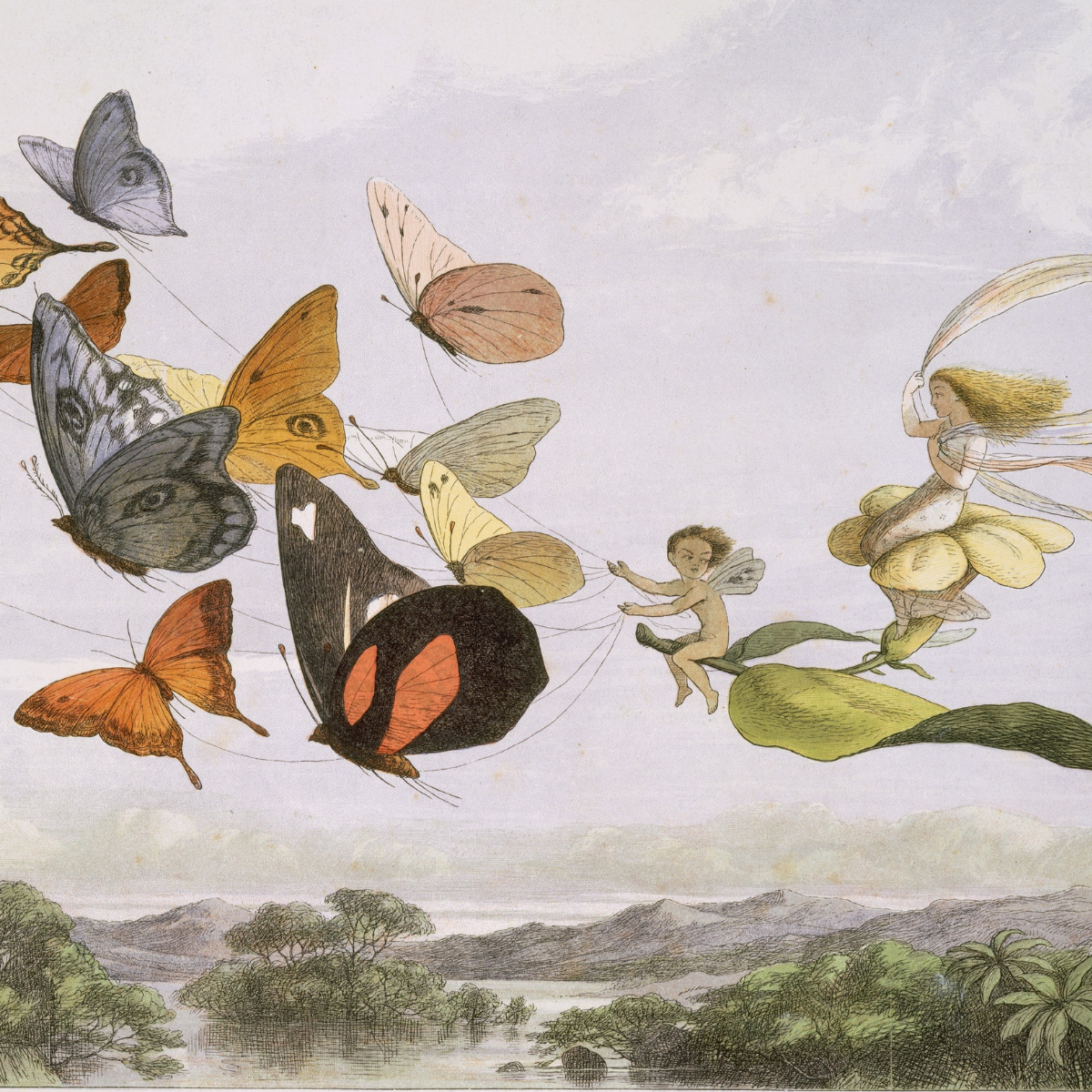There are many different ways to experience faerie folklore: through shared oral tradition, by reading tales collected by folklorists, and via its inclusion in literature, art, and even science. I find the interchange between folklore and creative endeavors fascinating, so I thought we’d explore how faerie folklore was incorporated into literature during different literary periods. And we’ll see how the faeries mingled with art and science as well. 🙂 Please note that this is meant to be an introductory overview and not a detailed exploration.
The Literary Faeries of Medieval Romances
Medieval folklore writings reveal a wide variety of faeries—from the small portunes (who behaved quite similarly to Puck, hobgoblins, or brownies) to human-sized, stately faeries. Katharine Briggs in her book, An Encyclopedia of Fairies: Hobgoblins, Brownies, Bogies, and Other Supernatural Creatures, describes the literary faeries of medieval romances in this way:
[They are] … of human size and often amorous of mortals, expert in enchantment and glamour, generally beautiful but occasionally hideous hags. Many of them are half-forgotten gods and goddesses, euhemerized into mortals with magical powers.
She notes that the literary faeries of this time were portrayed in this fashion because medieval romances arose from Celtic hero stories. We can see an example of this in the medieval poem, Sir Gawain and the Green Knight. Morgain le Fay (Gawain’s aunt and King Arthur’s half sister) is a human-sized faerie capable of enchanting her own appearance as well as that of others. Additionally, the story has Celtic, heroic legend origins, as it is a beheading match tale type. (Not to worry—while the beheading is described with great detail in the poem, it is actually a trick of magic.)
Elizabethan and Jacobean Faeries
As we move through time, the faeries of Elizabethan and Jacobean literature reflect the taste of a new type of writer—one who came from the countryside to town, bringing folk traditions with them. These writers fancied two types of faeries in particular: the hobgoblin (Puck!) and very small, nature faeries.
As we explored a few months ago, the folk tradition is strongly represented in Shakespeare’s Puck (a hobgoblin also known as Robin Goodfellow)—he is a faerie straight out of folklore. The small faeries, though, seem to have meandered from medieval folklore into Elizabethan and Jacobean literature in a less tangible manner.
It is thought that Shakespeare and his play, A Midsummer Night’s Dream, popularized miniature faeries and their attachment to flora. In the article “Shakespeare and the Fairies,” Roger Lancelyn Green describes these small, nature faeries:
But Shakespeare’s diminutive Fairies are always perfectly formed and creatures of pure beauty—nor, in A Midsummer Night’s Dream, is the size stressed over much: for of course the actual parts [in the drama] could only be taken by children. The feeling of smallness is given simply by the odd reference: ‘creep into acorn cups’ — bats’ wings ‘to make my small elves coats’, and Bottom’s warning to Cobweb ‘I would be loth to have you overflown with a honey-bag’ — the ‘adventurous fairy that shall seek the squirrel’s hoard, and fetch thee hence new nuts’, must be a little larger.
Their petite stature did not mean that they were less powerful, though. Shakespeare ensured that they could travel swiftly, influence the seasons, and alter their own size.

The Fairy Godmother Enters into Literature
Though the popularity of miniature faeries continued through the centuries, the late 17th and early 18th centuries brought a new human-sized faerie to literature: the fairy godmother. Katharine Briggs explains that within the pages of the French fairy tales written by Madame d’Aulnoy and Charles Perrault are “… traditional tales, polished to meet the taste of the French court ….” Furthermore, Briggs reminds us that human-sized faeries “never disappeared from tradition,” but were “reinforced by the fairy godmother.”
Roger Lancelyn Green also discusses the fairy godmother in his article. He describes how Perrault added her to his retelling of “Cinderella.” (There was no fairy godmother in Grimm’s version of the tale.) Green notes that the fairy godmother does not appear to look different from any other woman, but she is named as a faerie by Perrault and has magical abilities.
Faeries With Wings?
Directly following his discussion on the fairy godmother, Green makes an interesting (and surprising!) observation:
Fairies seem to have begun to grow wings during the proliferation of ‘Court’ fairytales in France during the century, culminating in the forty-three volumes of the Cabinet des Fées published a few years before the Revolution.
Faeries with wings? It is not common within folklore for faeries to have wings. They did employ different types of levitation, like using ragwort stems or twigs to fly upon, often with the use of a magic password, but not wings. So how did they grow their wings, so to speak?
It appears that The Rape of the Lock, the mock-epic poem by Alexander Pope, holds the answer to this question. In the article “Nature’s Invisibilia: The Victorian Microscope and the Miniature Fairy,” Laura Forsberg explains:
In the eighteenth century, Alexander Pope added the concrete feature of “insect-wings” (2.61) to his fairies or “Sylphs” (2.75) in The Rape of the Lock (1717). This detail captivated the imagination of artists, prompting Henry Fuseli to depict the titular subject of Robin Goodfellow-Puck (1787–90) with bat wings. A few years later, Thomas Stothard first represented fairies bearing butterfly wings in his 1797 illustrations for Pope’s poem. Stothard’s illustrations gave a vivid visual form to the heretofore abstract conceit of the miniature fairy and established the fairy in the public’s imagination as a figure halfway between miniature human and personified insect.
Stothard’s application of butterfly wings to miniature faeries (which he painted from directly studying butterflies) initiated a shift in how people thought of faeries and encouraged other artists to combine nature with the fantastic. Rather than being part of a hearth tale, faeries began to give people a way to look more closely at the natural world.

The Victorian Period: Faeries and Microscopes
Additionally, industrialization and advancements in science chipped away at folklore as a way to understand the unknown. Soon came the Victorian period, and with it, a scientific tool that had become a mainstream object: the microscope. The Victorian faerie flew between folklore and science, appearing in both scientific texts as well as in literature and art. Forsberg explains this symbiotic relationship in the following way:
The convergence of scale between the microscope and the fairy fostered a strong imaginative link between the two. Natural scientists used the imagery of fairyland to convey the incomprehensible strangeness and minutiae of the microscopic world, while fairy authors and illustrators drew upon microscopic discoveries to lend a sense of reality to their unbelievable imaginings.
Forsberg argues that this connection between the microscope and faeries offers a different interpretation of faerie literature and art during the Victorian era. The faeries of the 19th century are often viewed under a “frivolous and trivial” lens. They were being portrayed as tiny, winged inhabitants of flowers and mushrooms, instead of the formidable folkloric creatures they were once believed to be. But Forsberg encourages us to consider these delicate faeries in a more substantive light—as a societal observation of that era’s scientific, microscopic discoveries.
Literature Returns to Faerie Folklore
By the beginning of the 19th century, faerie tradition was becoming available in the form of folktale collections throughout Britain. But it still took some time for folklore to reinsert itself into faerie literature. Briggs explains that Rudyard Kipling embraced the folkloric Puck in his book Puck of Pook’s Hill in the early 20th century. And then came J. R. R. Tolkien’s The Hobbit and The Lord of the Rings trilogy. Tolkien’s books added a new dimension to faerie literature. He incorporated modern problems and themes into tales grounded in folklore. And while Tolkien’s books were based on Scandinavian mythology (in which the faerie people were elves), they still resonated with people with different folklore traditions.
Faerie literature today continues to embrace this return to folklore. Some authors are quite faithful to faerie tradition, while other use it as a starting point to build their story from. The faeries have returned to being powerful beings and the theme of a faerie court (much like a human monarchy) is common.
An Encyclopedia of Fairies
Since we’re on the topic, I thought I’d share a picture of my favorite faerie folklore book—An Encyclopedia of Fairies: Hobgoblins, Brownies, Bogies, and Other Supernatural Creatures by Katharine Briggs. You may have heard of it, as I reference it about every other post. 🙂

I first came across her book through my local library. When the return date approached, I discovered that I could not live without it. It is so thorough and detailed. Four hundred and eighty-one pages of faerie folklore! And according to the publisher, “Twenty-one plates, 39 text figures, an extensive bibliography, and an index of types and motifs complete this fascinating journey through the land of enchantment.” Excellent!
So I tracked down a used copy (it was published in 1976) and purchased it. It has been well loved—my copy was once in a library as well. It even has the library checkout card still in its pocket. Every time I use it I am in awe of Briggs’ accomplishment in creating this resource.
Art credit (featured image): In Fairyland: A Series of Pictures from the Elf-World by Richard Doyle via The Metropolitan Museum of Art, licensed under CC0




